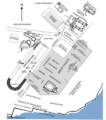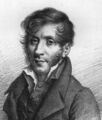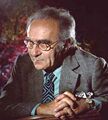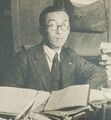Template:Selected anniversaries/January 18: Difference between revisions
No edit summary |
No edit summary |
||
| (4 intermediate revisions by the same user not shown) | |||
| Line 5: | Line 5: | ||
||1707: Otto Mencke dies ... philosopher and scientist. He founded ''Acta Eruditorum'', the first scientific journal in Germany, in 1682. Pic. | ||1707: Otto Mencke dies ... philosopher and scientist. He founded ''Acta Eruditorum'', the first scientific journal in Germany, in 1682. Pic. | ||
||1779: Peter Mark Roget born ... physician, lexicographer, and theologian. Pic. | ||1779: Peter Mark Roget born ... physician, lexicographer, and theologian. Pic. | ||
| Line 19: | Line 17: | ||
||1854: Thomas A. Watson dies ... assistant to Alexander Graham Bell. Pic. | ||1854: Thomas A. Watson dies ... assistant to Alexander Graham Bell. Pic. | ||
||1856: Daniel Hale Williams born ... surgeon, who in 1893 performed the second documented successful pericardium surgery to repair a wound in the United States of America. He also founded Provident Hospital---the first non-segregated hospital in the United States---in Chicago, Illinois. Pic. | ||1856: Daniel Hale Williams born ... surgeon, who in 1893 performed the second documented successful pericardium surgery to repair a wound in the United States of America. He also founded Provident Hospital---the first non-segregated hospital in the United States---in Chicago, Illinois. Pic. | ||
| Line 35: | Line 31: | ||
||1874: Hans Reissner born ... aeronautical engineer whose avocation was mathematical physics. He solved Einstein's equation for the metric of a charged point mass. His Reissner–Nordström metric demonstrated that an electron has a naked singularity rather that an event horizon. Pic. | ||1874: Hans Reissner born ... aeronautical engineer whose avocation was mathematical physics. He solved Einstein's equation for the metric of a charged point mass. His Reissner–Nordström metric demonstrated that an electron has a naked singularity rather that an event horizon. Pic. | ||
File:Antoine Becquerel.jpg|link=Antoine César Becquerel (nonfiction)|1878: Physicist and academic [[Antoine César Becquerel (nonfiction)|Antoine César Becquerel]] dies. He pioneered the study of electric and luminescent phenomena. | File:Antoine Becquerel.jpg|link=Antoine César Becquerel (nonfiction)|1878: Physicist and academic [[Antoine César Becquerel (nonfiction)|Antoine César Becquerel]] dies. He pioneered the study of electric and luminescent phenomena. | ||
| Line 46: | Line 40: | ||
||1896: An X-ray generating machine is exhibited for the first time by H. L. Smith. | ||1896: An X-ray generating machine is exhibited for the first time by H. L. Smith. | ||
||1901: Ivan Petrovsky born ... mathematician and academic ... | ||1901: Ivan Petrovsky born ... mathematician and academic ... Soviet mathematician working mainly in the field of partial differential equations. He greatly contributed to the solution of Hilbert's 19th and 16th problems, and discovered what are now called Petrovsky lacunas. He also worked on the theories of boundary value problems, probability, and on the topology of algebraic curves and surfaces. Pic search: https://www.google.com/search?q=Ivan+Petrovsky | ||
||1905: Joseph Bonanno born ... mob boss. Pic. | ||1905: Joseph Bonanno born ... mob boss. Pic. | ||
| Line 54: | Line 48: | ||
||1911: Eugene B. Ely lands on the deck of the USS Pennsylvania stationed in San Francisco Bay, the first time an aircraft landed on a ship. Pic. | ||1911: Eugene B. Ely lands on the deck of the USS Pennsylvania stationed in San Francisco Bay, the first time an aircraft landed on a ship. Pic. | ||
||1911: Shoichi Sakata born . | File:Sakata Shoichi.jpg|link=Shoichi Sakata (nonfiction)|1911: Physicist [[Shoichi Sakata (nonfiction)|Shoichi Sakata]] born. Sakata will contribute theoretical work on the structure of the atom, proposing the Sakata model, an early precursor to the quark model. After World War II he will campaign for the peaceful uses of nuclear power. | ||
||1921: Belding Hibbard Scribner born ... physician and a pioneer in kidney dialysis. Pic search good: https://www.google.com/search?q=Belding+Hibbard+Scribner | ||1921: Belding Hibbard Scribner born ... physician and a pioneer in kidney dialysis. Pic search good: https://www.google.com/search?q=Belding+Hibbard+Scribner | ||
| Line 62: | Line 56: | ||
||1923: Boleslav Kornelievich Mlodzeevskii dies ... mathematician, a former president of the Moscow Mathematical Society. He will work in differential and algebraic geometry. Pic. | ||1923: Boleslav Kornelievich Mlodzeevskii dies ... mathematician, a former president of the Moscow Mathematical Society. He will work in differential and algebraic geometry. Pic. | ||
File:Crossword.png|link=Crossword (nonfiction)|1924: First use of [[Crossword (nonfiction)|crossword puzzles]] powered by [[Gnomon algorithm functions]] to detect and prevent [[crimes against mathematical constants]]. | |File:Crossword.png|link=Crossword (nonfiction)|1924: First use of [[Crossword (nonfiction)|crossword puzzles]] powered by [[Gnomon algorithm functions]] to detect and prevent [[crimes against mathematical constants]]. | ||
||1926: Randolph Bromery born ... geologist and academic. Pic search | ||1926: Randolph Bromery born ... geologist and academic. Pic search | ||
||1933: Ray Dolby born ... engineer and businessman, founded Dolby Laboratories. Pic. | ||1933: Ray Dolby born ... engineer and businessman, founded Dolby Laboratories. Pic. | ||
||1955: Rodica Eugenia Simion born ... mathematician. She was the Columbian School Professor of Mathematics at George Washington University. Her research concerned combinatorics: she was a pioneer in the study of permutation patterns, and an expert on noncrossing partitions. Pic: https://gilkalai.wordpress.com/2010/01/07/rodica-simion-immigrant-complex/ | ||1955: Rodica Eugenia Simion born ... mathematician. She was the Columbian School Professor of Mathematics at George Washington University. Her research concerned combinatorics: she was a pioneer in the study of permutation patterns, and an expert on noncrossing partitions. Pic: https://gilkalai.wordpress.com/2010/01/07/rodica-simion-immigrant-complex/ | ||
||1963: Edward Charles Titchmarsh dies ... mathematician. Pic search | ||1963: Edward Charles Titchmarsh dies ... mathematician. Pic search. | ||
||1971: Arnold Nordsieck dies ... theoretical physicist. He is best known for his work with Felix Bloch on the infrared problem in quantum electrodynamics. He developed the inertial electrostatic gyroscope (ESG) used as part of the inertial navigation system of nuclear submarines that allows them to remain underwater without having to surface to ascertain their location. Pic: https://www.ion.org/museum/item_view.cfm?cid=2&scid=4&iid=30 | ||1971: Arnold Nordsieck dies ... theoretical physicist. He is best known for his work with Felix Bloch on the infrared problem in quantum electrodynamics. He developed the inertial electrostatic gyroscope (ESG) used as part of the inertial navigation system of nuclear submarines that allows them to remain underwater without having to surface to ascertain their location. Pic: https://www.ion.org/museum/item_view.cfm?cid=2&scid=4&iid=30 | ||
Latest revision as of 13:06, 17 January 2022
532: The Nika riots fail in Constantinople. Nearly half the city is burned or otherwise destroyed, and tens of thousands of people are dead.
1802: Carl Friedrich Gauss read in the newspaper that Olbers had rediscovered Ceres. Gauss wrote to get the observations and a long friendship ensued. Gauss was such an avid newspaper reader that students nicknamed him the “newspaper bear” because of his habits in the library reading room. If someone was reading the paper he wanted he would sit glumly nearby and stare at them until they gave up the paper.
1825: Chemist Edward Frankland born. He will be one of the originators of organometallic chemistry, introducing the concept of combining power or valence.
1873: Mathematician, engineer, cartographer, economist, and politician Charles Dupin dies. In 1826 created the earliest known choropleth map.
1878: Physicist and academic Antoine César Becquerel dies. He pioneered the study of electric and luminescent phenomena.
1908: Mathematician, historian of science, theatre author, poet, and inventor Jacob Bronowski born.
1911: Physicist Shoichi Sakata born. Sakata will contribute theoretical work on the structure of the atom, proposing the Sakata model, an early precursor to the quark model. After World War II he will campaign for the peaceful uses of nuclear power.






